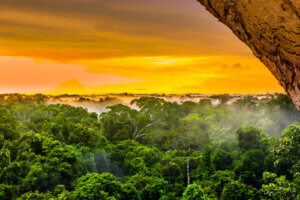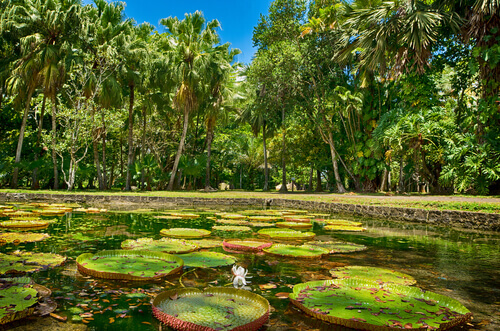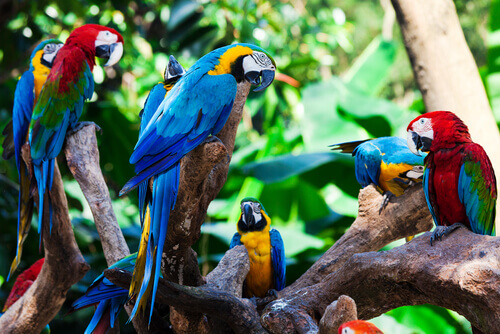The Biodiversity of the Amazon, The Most Alive River on Earth

The biodiversity of the Amazon River region represents one of the highest percentages of biodiversity on our planet. This river has produced one of the richest and most diverse ecosystems on our planet and serves as a refuge for millions of species of animals and plants, many still undiscovered.
The geography and climatology of Amazonia
The Amazon River was born 10 million years ago. The evolution of the flora and fauna of the Amazon region, however, can be traced back to the time when the movement of tectonic plates created the Andes Mountains 20 million years ago.
This is according to a study that an international team from the Spanish National Research Council (CSIC) carried out. Their research seeks to formulate new theories to explain the complexity and origin of the amazing biodiversity of the Amazon.
The Amazon consists of the vast region comprising the central and northern parts of South America and also includes the tropical rain forest of the Amazon basin. It covers an area of 4,350,000 square miles.

This zone marks the rainy season in Venezuela. And, at the same time, it’s responsible for the tropical climate of the Amazon. In other words, abundant rainfall, humidity, and high temperatures, the ideal breeding ground for life.
The biodiversity of the Amazon, beyond all expectations
According to estimates, around 60% of all species on the planet inhabit the Amazon rain forest. What’s more, the scientific community has yet to discover 30% of these species.
Among the million living beings that we can find in this region, there may be up to 2,500 types of fish, 3,500 types of trees, and 300 species of reptiles. These include snakes and lizards.
According to the Coordinator of the Indigenous Organizations of the Amazon Basin (COICA), around 9% of the Amazon’s human population still consists of indigenous peoples. In fact, there are up to 350 different ethnicities.

Unfortunately, the economic exploitation causing this loss of vegetation affects both the flora and fauna of the region. What’s more, it threatens to destabilize the dynamics of what many call the lungs of the Earth.
The importance of the Amazon rain forest lies in its ability to regulate both the temperature and humidity of the environment. Both are closely linked to hydrological cycles.
The Amazon rain forest holds a reserve of between 90 and 140 billion metric tons of carbon. However, the release of this carbon into the atmosphere could drastically accelerate climate change.
Each year, it releases 500 million metric tons of carbon. This positions the Amazon as one of the major climate regulators of our planet. The Amazon’s biodiversity is diminishing. And it will continue to diminish, without regulation of the exploitation that is beginning to affect the “Earth’s lung”.
The biodiversity of the Amazon River region represents one of the highest percentages of biodiversity on our planet. This river has produced one of the richest and most diverse ecosystems on our planet and serves as a refuge for millions of species of animals and plants, many still undiscovered.
The geography and climatology of Amazonia
The Amazon River was born 10 million years ago. The evolution of the flora and fauna of the Amazon region, however, can be traced back to the time when the movement of tectonic plates created the Andes Mountains 20 million years ago.
This is according to a study that an international team from the Spanish National Research Council (CSIC) carried out. Their research seeks to formulate new theories to explain the complexity and origin of the amazing biodiversity of the Amazon.
The Amazon consists of the vast region comprising the central and northern parts of South America and also includes the tropical rain forest of the Amazon basin. It covers an area of 4,350,000 square miles.

This zone marks the rainy season in Venezuela. And, at the same time, it’s responsible for the tropical climate of the Amazon. In other words, abundant rainfall, humidity, and high temperatures, the ideal breeding ground for life.
The biodiversity of the Amazon, beyond all expectations
According to estimates, around 60% of all species on the planet inhabit the Amazon rain forest. What’s more, the scientific community has yet to discover 30% of these species.
Among the million living beings that we can find in this region, there may be up to 2,500 types of fish, 3,500 types of trees, and 300 species of reptiles. These include snakes and lizards.
According to the Coordinator of the Indigenous Organizations of the Amazon Basin (COICA), around 9% of the Amazon’s human population still consists of indigenous peoples. In fact, there are up to 350 different ethnicities.

Unfortunately, the economic exploitation causing this loss of vegetation affects both the flora and fauna of the region. What’s more, it threatens to destabilize the dynamics of what many call the lungs of the Earth.
The importance of the Amazon rain forest lies in its ability to regulate both the temperature and humidity of the environment. Both are closely linked to hydrological cycles.
The Amazon rain forest holds a reserve of between 90 and 140 billion metric tons of carbon. However, the release of this carbon into the atmosphere could drastically accelerate climate change.
Each year, it releases 500 million metric tons of carbon. This positions the Amazon as one of the major climate regulators of our planet. The Amazon’s biodiversity is diminishing. And it will continue to diminish, without regulation of the exploitation that is beginning to affect the “Earth’s lung”.
This text is provided for informational purposes only and does not replace consultation with a professional. If in doubt, consult your specialist.








